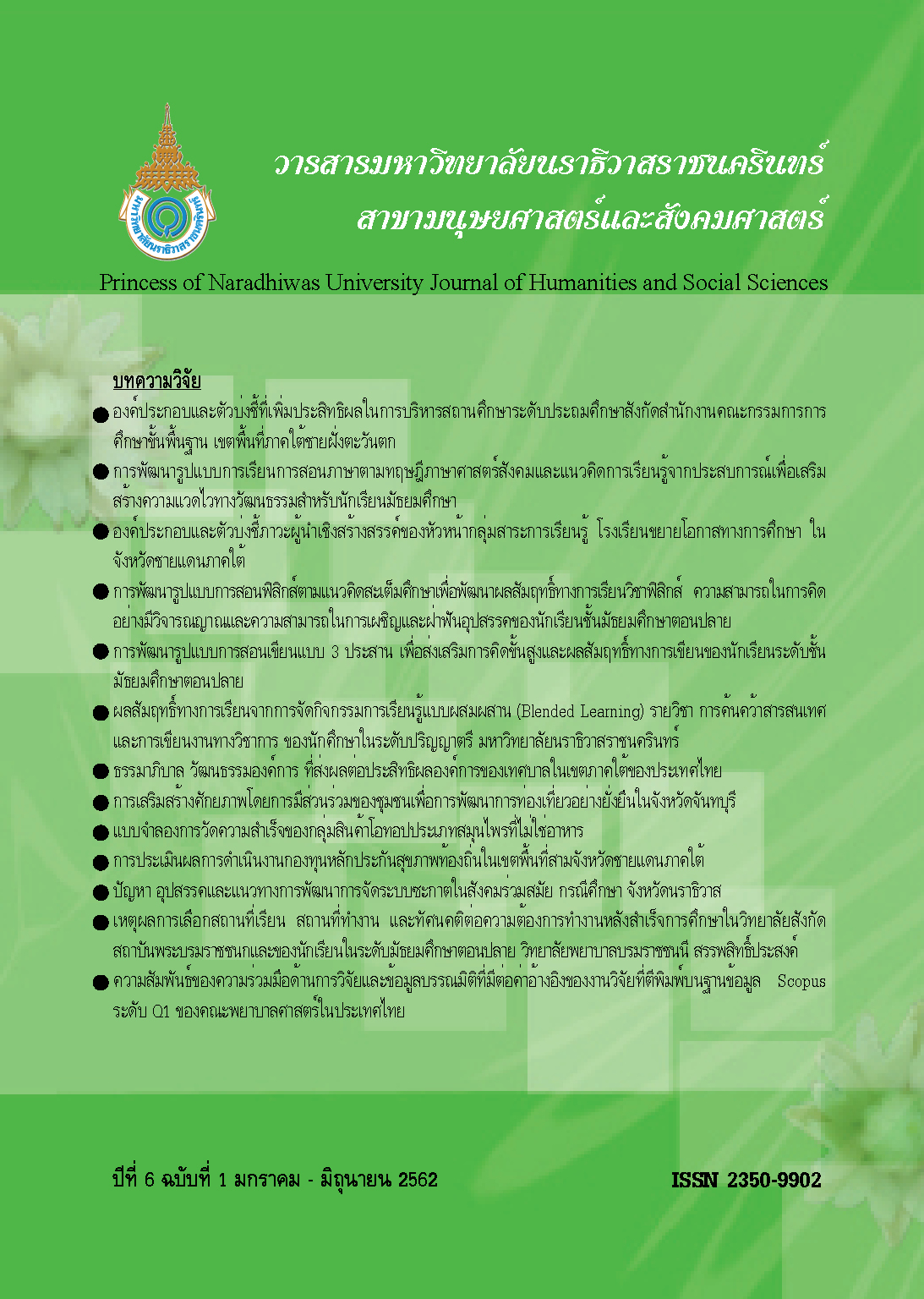การพัฒนารูปแบบการเรียนการสอนภาษาตามทฤษฎีภาษาศาสตร์สังคมและแนวคิดการเรียนรู้จากประสบการณ์เพื่อเสริมสร้างความแวดไวทางวัฒนธรรมสำหรับนักเรียนมัธยมศึกษา
Main Article Content
Abstract
The purpose of this research was to develop a language instructional model based on sociolinguistic theory & experiential learning approach to enhance cultural sensitivity of secondary school students & to evaluate the effectiveness of the developed instructional model. The sample was 37 Mathayom 5 students & they were selected by using purposive r&om sampling. The time series design which took 16 weeks of the experiment was implemented in this research. The research instrument was the Cultural Sensitivity Test for Secondary Students. The data were analyzed by using the arithmetic mean, the st&ard deviation, & the dependent t-test.
The findings of this study revealed that the principles of the instructional model are to create the bridge between learners’ prior experience concerning language & culture & their new experience in order to highlight the value & the importance of their learning & make it more meaningful to them. The language learning happens through social interaction in multicultural situations that provides safe & nurturing atmosphere for learners & when learners interact with people from various socio-cultural contexts & share their views towards what they have done, they tend to realize cultural differences between people. This instructional model consists of 5 stages; 1) reexperience 2) react 3) reflect 4) refine & 5) refer. In addition, the result of the effectiveness of the developed instructional model demonstrated that the sample group had significantly higher post-test mean scores than the pre-test at the level of .05 both in overall score & scores of each component of cultural sensitivity.
Article Details
References
สำนักงานจังหวัดพระนครศรีอยุธยา. (2558). บรรยายสรุปประจำปี 2558 จังหวัดพระนครศรีอยุธยา. สืบค้นเมื่อวันที่ 2
มกราคม 2561 จาก http://ww2.ayutthaya.go.th/files/com_news_document/2016-04_7763b5affc10449.pdf
Bhawuk, D. P. S., & Brislin, R. W. (1992). The measurement of intercultural sensitivity using the concept of
individualism & collectivism. International Journal of Intercultural Relations, 16, 413-436
Brislin, R. & Yoshida, T. (1994). Intercultural communication training: An introduction. Thous& Oaks, CA: Sage
publications.
Chen, G. M. & Starosta, W. J. (1996). Intercultural communication competence: A synthesis. In B. Burleson (Ed.),Communication Yearbook 19. Thous & Oaks: Sage.
Chen, G. M. & Starosta, W. J. (1997). A review of the concept of intercultural sensitivity. Human Communication,
, 1-16.
Chen G. M. & Starosta, W. (2000). The development & validation of intercultural sensitivity scale. Paper
presented at the Annual Meeting of the National Communication Association, Seattle, WA.
Davis, S. L., & Finney, S. J. (2006). A factor analytic study of the cross-cultural adaptability inventory.
Educational & Psychological Measurement, 66(2), 318-330.
Foronda, C. (2008). A concept analysis of cultural sensitivity. Journal of Transcultural Nursing, 19(3), 207-212
Fritz, W., Graf, A., Hentze, J., Mollenberg, A., & Chen G. H. (2005). An examination of chen & starosta's
model of intercultural sensitivity in Germany & United States. In Chen, G. M. (2010). A study of
intercultural communication competence. Hong Kong: China Review Academic Publishers.
Gudykunst, W. B., & Hammer, M. R. (1983). Basic training design: Approaches to intercultural training. In
D. L&is & R. W. Brislin (Eds.), H&book of intercultural training, volume 1: Issues in theory & design
(pp. 118-154). New York: Pergamon.
Halliday, M. A. K. (1975). Learning how to mean: explorations in the development of language. London: Edward Arnold.
Halliday, M. A. K. (1978). Language as a social semiotic: the social interpretation of language & meaning.
London: Edward Arnold.
Hart, R. P. & Burks, D. M. (1972). Rhetorical sensitivity & social interaction. Speech Monographs, 39, 75-91.
Hudson, R. A. (1996). Sociolinguistics. Cambridge: Cambridge University Press.
Keengwe, J. P. (2010). Fostering cross cultural competence in preservice teachers through multicultural
education experiences. Early Childhood Education Journal, 38, 197-204.
Kolb, A. Y. & Kolb, D. A. (2008). Experiential learning theory: Dynamic, holistic approach to management
learning, education & development. In S. J. Armstrong & C. Fukami (Eds.) H&book of Management
Learning, Education & Development. London: Sage Publications.
Lister, P. (1999). A taxonomy for developing culture competence. Nurse Education Today. 19(4), 103-115.
Muniry, M., Nair, G., Krishnan, S., Ahmad, I., & Noor, N. (2010). Sociolinguistic competence & Malaysian
students' English language proficiency. English Language Teaching, 3(3), 145-151.
Piaget, J. (1926). The language & thought of the child. New York: Harcourt Brace & Company.
Skepple, R. G. (2014). Preparing culturally responsive pre-service teachers for culturally diverse classroom.
Kentucky Journal of Excellence in College Teaching & Learning, 12(6), 57-69.
Tat, D. K. L. (2012). The application of sociolinguistic relativity acquisition in teaching English in intensive
English program in Vietnamese secondary schools. The Internet Journal of Language, Culture &
Society, 34, 51-58.
UNESCO. (1999). Learning to Live Together: Education Policies & Realities in Asia-Pacific. Retrieve 30
August 2016 from http://unesdoc.unesco.org/images/0022/002272/227208e.pdf
Vygotsky, L. S. (1978). Mind in Society. Cambridge, MA: Harvard University Press.
Wardhaugh, R. (2010). An Introduction to Sociolinguistics. New York: Basil Blackwell Inc.
Zhang, H. & Wang, N. (2016). Sociolinguistics & English teaching in china. Theory & Practice in Language
Studies, 694), 830-834.


